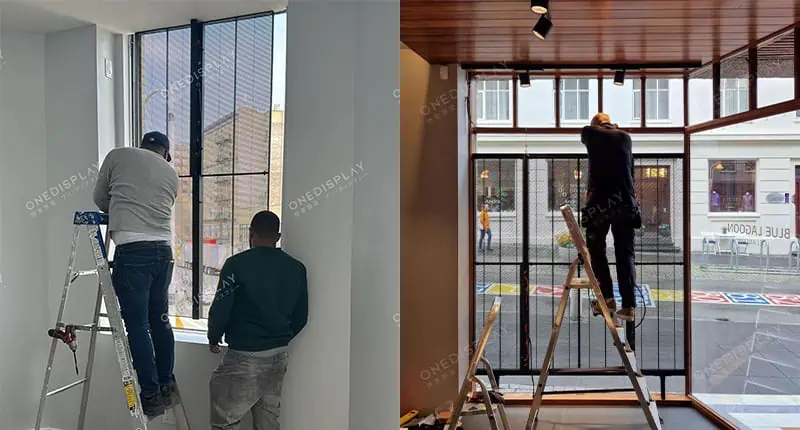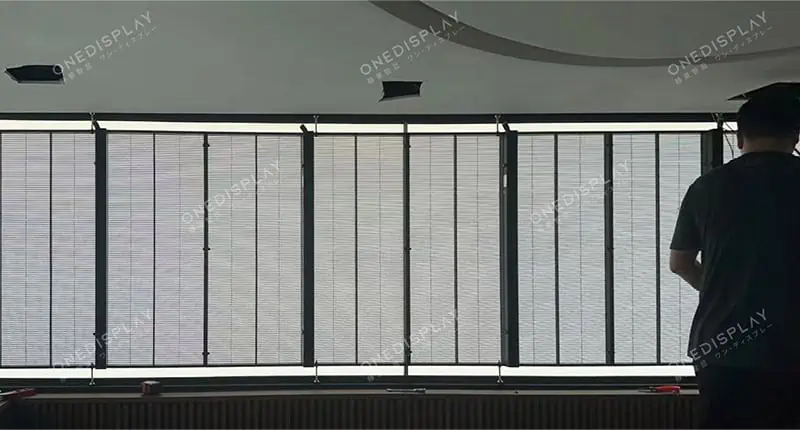With their unique ability to seamlessly blend with the surroundings while showcasing vibrant content, transparent LED screens offer an innovative and visually appealing solution. This comprehensive guide will walk you through the process of installing your own transparent LED screen, covering everything from the initial considerations to troubleshooting and maintenance.
Introduction
In today’s competitive market, businesses are constantly seeking new and creative ways to engage with their target audience. Transparent LED screens have emerged as a popular choice due to their ability to capture attention while maintaining the aesthetics of the surrounding environment. By combining the benefits of LED technology with transparency, these screens provide a dynamic platform for displaying content in a visually striking manner.
What is a Transparent LED Screen?
A transparent LED screen, also known as a see-through display, is a display panel that utilizes light-emitting diodes (LEDs) to create visual content. Unlike traditional LED screens, transparent LED screens have a unique construction that allows light to pass through the display, making them see-through. This transparency is achieved by employing a grid-like structure that allows light to transmit through the screen while maintaining the display’s visibility.
Advantages of Transparent LED Screens
Enhanced Aesthetics
One of the primary advantages of transparent LED screens is their ability to enhance the aesthetics of any space. These screens seamlessly integrate with the existing architecture, be it storefronts, shopping malls, or corporate offices, without obstructing the view. By blending with the surroundings, transparent LED screens create an immersive visual experience that captures the attention of passersby.
Transparency and Visibility
The unique feature of transparency sets transparent LED screens apart from traditional displays. With their high transparency, these screens offer unobstructed views of the background while simultaneously displaying captivating content. This makes them an ideal choice for applications where visibility is crucial, such as retail environments, museums, and exhibition halls.
Energy Efficiency
Transparent LED screens are designed with energy efficiency in mind. Their construction allows for effective utilization of natural light, reducing the need for excessive artificial lighting. Additionally, transparent LED screens consume less power compared to conventional displays, resulting in cost savings and a reduced environmental footprint.
Versatility
Another significant advantage of transparent LED screens is their versatility. These screens are available in various shapes, sizes, and configurations, enabling customization to fit specific requirements. Whether it’s a curved installation or a freestanding display, transparent LED screens offer flexibility and adaptability to suit different spaces and applications.
Factors to Consider Before Installation
Before diving into the installation process, it’s essential to consider several factors to ensure a successful implementation of your transparent LED screen. By carefully evaluating these aspects, you can optimize the installation for maximum impact and longevity.
Location and Environment
The location plays a crucial role in determining the effectiveness of a transparent LED screen. Consider factors such as ambient lighting, viewing angles, and foot traffic in the chosen location. Assess the environmental conditions, including temperature, humidity, and exposure to the elements, to select a screen that can withstand the conditions of the installation site.
Size and Resolution
Determining the appropriate size and resolution of the transparent LED screen is vital to achieve optimal visual impact. Consider the viewing distance, available space, and desired content resolution when selecting the screen size. Higher resolutions are recommended for closer viewing distances and detailed content, while larger screens are better suited for spacious areas with greater viewing distances.
Connectivity and Control System
Ensure that the transparent LED screen is compatible with your existing infrastructure and control systems. Consider the connectivity options such as HDMI, DVI, or Ethernet, depending on your requirements. Select a control system that offers user-friendly software for content management and scheduling.
Content Management
Efficient content management is essential for a transparent LED screen’s success. Determine the source of content, whether it’s real-time data, pre-designed graphics, or videos. Ensure compatibility with the chosen content management software to streamline the process of creating, scheduling, and updating content.
Maintenance and Support
Transparent LED screens, like any electronic device, require regular maintenance and support. Consider the availability of technical support, warranty coverage, and spare parts for your chosen screen. Familiarize yourself with the recommended maintenance practices to ensure the longevity and optimal performance of your transparent LED screen.
Preparing for Installation
Once you have considered the crucial factors and selected the appropriate transparent LED screen, it’s time to prepare for the installation process. Adequate preparation will ensure a smooth and efficient installation, minimizing any potential issues that may arise.
Site Survey and Assessment
Conduct a thorough site survey to assess the installation site. Take precise measurements of the available space and consider any structural limitations or requirements. Identify potential obstacles or obstructions that may affect the installation process.
Structural Considerations
Transparent LED screens require a stable and secure mounting structure. Ensure that the chosen mounting option can support the weight of the screen and withstand environmental factors such as wind loads. Consult with professionals, such as structural engineers or installers, to ensure the structural integrity of the installation.
Power and Electrical Requirements
Proper power supply and electrical infrastructure are critical for the successful operation of transparent LED screens. Determine the power requirements of the screen and ensure the availability of adequate power outlets or electrical connections. Consult with an electrician to ensure compliance with local electrical codes and regulations.
Content Creation and Scheduling
Prepare the content that will be displayed on the transparent LED screen. Depending on your requirements, this may involve designing graphics, creating videos, or integrating real-time data sources. Set up a content scheduling plan to ensure a dynamic and engaging display.
Installation Process
Now that you have completed the necessary preparations, it’s time to proceed with the installation of your transparent LED screen. Follow these step-by-step instructions to ensure a successful and hassle-free installation.
Unboxing and Inspection
Begin by carefully unboxing the transparent LED screen and inspecting it for any visible damage or defects. Check that all the necessary components and accessories are present.
Mounting and Alignment
Install the mounting structure based on the site survey and structural considerations. Ensure that the mounting brackets or frames are securely fastened and aligned correctly. Double-check the levelness and stability of the structure.
Connecting and Wiring
Connect the transparent LED screen to the control system and power source. Follow the manufacturer’s instructions for the specific wiring and connection requirements. Ensure that all connections are secure and properly insulated.
Calibration and Testing
Once the connections are established, calibrate the transparent LED screen to ensure optimal image quality and color accuracy. Use the calibration software provided by the manufacturer and follow the recommended calibration procedures. Test the screen thoroughly to verify its functionality and performance.
Content Management and Control
After the successful installation of your transparent LED screen, it’s time to focus on content management and control. Effective management of content will ensure that your display remains engaging and up-to-date.
Content Creation and Design
Create captivating content that aligns with your branding and messaging objectives. Consider the unique aspects of a transparent LED screen and design content that utilizes its transparency and visual impact. Use high-resolution images, dynamic videos, and eye-catching graphics to attract and retain viewers’ attention.
Scheduling and Playback
Develop a content scheduling plan that ensures a dynamic and varied display. Consider the time of day, target audience, and specific events or promotions. Utilize the scheduling features of your chosen content management software to automate content updates and transitions.
Monitoring and Maintenance
Regularly monitor the performance of your transparent LED screen to identify any issues or anomalies. Keep track of content playback, screen temperature, and connectivity status. Perform routine maintenance tasks such as cleaning the screen surface and checking for any loose connections.
Troubleshooting and Maintenance Tips
Despite careful planning and installation, issues may arise with your transparent LED screen. Here are some common troubleshooting tips and maintenance practices to address and prevent problems:
Common Issues and Solutions:
How To Repair and Maintain the Transparent LED Screen?
Cleaning and Protection
Regular cleaning of the transparent LED screen is crucial to maintain its visual clarity. Use non-abrasive, lint-free cloths and mild cleaning solutions to remove dust and smudges. Avoid applying excessive pressure or using harsh chemicals that may damage the screen surface.
Consider installing protective measures such as screen guards or filters to prevent physical damage and reduce the risk of vandalism or accidental impact.
Regular Maintenance Practices
Implement a regular maintenance schedule to ensure the optimal performance and longevity of your transparent LED screen. This may include routine inspections, cleaning sessions, software updates, and periodic recalibration. Follow the manufacturer’s guidelines and recommendations for specific maintenance tasks.
Conclusion
Installing a transparent LED screen can significantly enhance the visual appeal and engagement of your business or organization. By following this comprehensive guide, you have gained a solid understanding of the installation process and the considerations involved. Remember to evaluate the location, choose the appropriate size and resolution, and plan for effective content management. Regular maintenance and troubleshooting will ensure the long-term success of your transparent LED screen, providing an immersive and captivating visual experience for your audience.
FAQs
- How long does it take to install a transparent LED screen?
- The installation time depends on various factors such as the size of the screen, complexity of the mounting structure, and site-specific considerations. Typically, it can take anywhere from a few hours to a couple of days to complete the installation process.
- Can transparent LED screens be used outdoors?
- Yes, transparent LED screens can be used outdoors, provided they are specifically designed for outdoor use. Outdoor transparent LED screens are built to withstand environmental conditions such as rain, dust, and sunlight, ensuring durability and visibility in outdoor settings.
- Is it possible to customize the size and shape of a transparent LED screen?
- Yes, transparent LED screens offer customization options for size and shape. We can create screens with custom dimensions and shapes to fit unique installation requirements.
- What software is required to manage content on a transparent LED screen?
- Content management software is used to create, schedule, and manage content on transparent LED screens. Now, most customers choose the brands Novastar, Colorlight, mainly because they do good products and keep up with the service.
- Are transparent LED screens suitable for all types of businesses?
- Transparent LED screens can be beneficial for a wide range of businesses, including retail stores, restaurants, museums, corporate offices, and event venues. The versatility and visually captivating nature of transparent LED screens make them suitable for various industries and applications.


